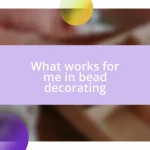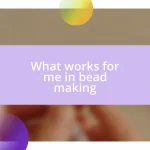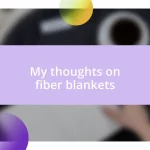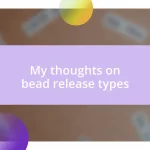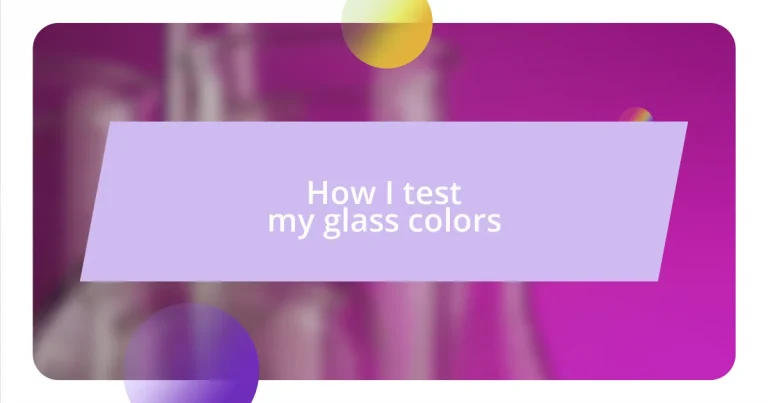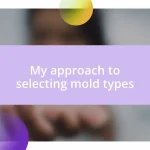Key takeaways:
- Understanding glass colors involves recognizing their material origins, how they interact with light and surroundings, and their emotional impact on spaces.
- Choosing the right glass sample depends on factors like color intensity, thickness, lighting conditions, and personal connection, ensuring it aligns with the intended environment.
- Documenting testing findings, including color measurements and emotional reflections, enhances creative processes and fosters collaboration with other artists.
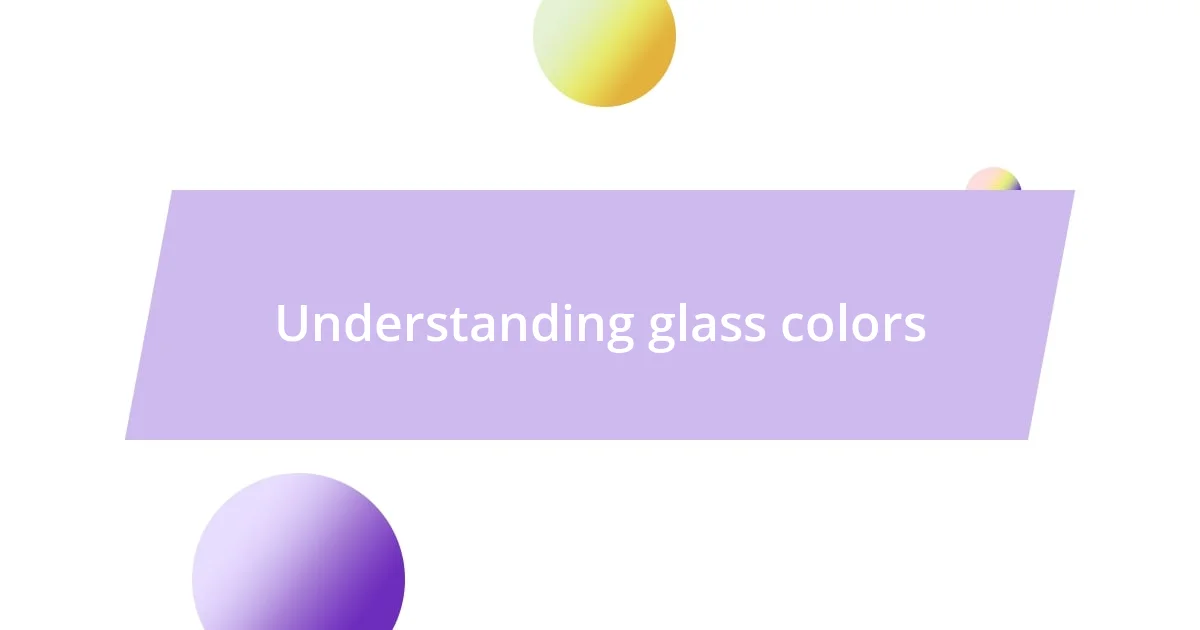
Understanding glass colors
Glass colors can be quite mesmerizing, serving not only as a decorative element but also influencing how we perceive light and space. I remember the first time I saw glass artwork illuminated by sunlight; the way the colors danced and played reminded me of how important it is to understand their properties. Have you ever noticed how certain hues can evoke specific feelings or memories?
When it comes to glass, the colors often stem from the materials used in the production process. For instance, cobalt oxide creates stunning blue shades, while gold results in deep reds. I used to get lost in the process of selecting glass for my projects, marveling at how each color changes depending on the thickness and light conditions. It’s almost like each piece has its own personality that can shift throughout the day.
Understanding glass colors also involves knowing how they interact with surrounding elements. For example, a vibrant green glass can evoke feelings of nature and tranquility but can appear quite different in a dimly lit room versus bright daylight. Have you ever experimented with glass color in your own environment? I’ve found that playing with different colors can completely transform the ambiance, bringing a space to life in ways I never expected.
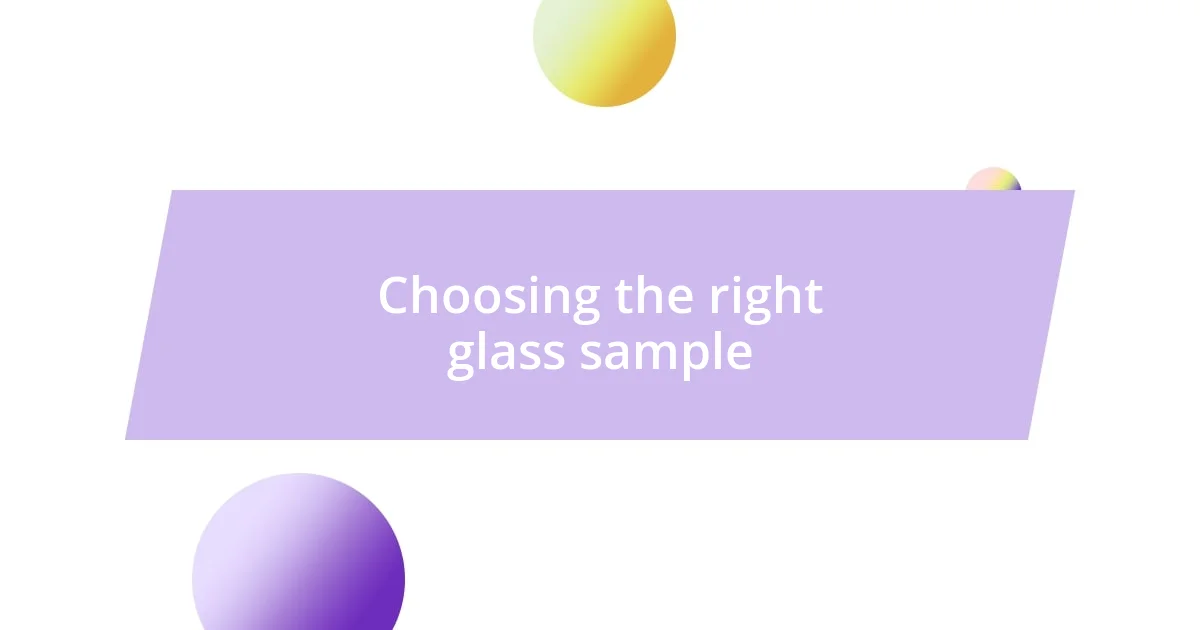
Choosing the right glass sample
Choosing the right glass sample is crucial for achieving the desired effect in any project. In my experience, the selection shouldn’t just be about aesthetics; it should also consider the intended environment and functionality. I’ve often found that what looks stunning in a showroom may not translate well in my actual workspace, especially when natural light interacts with the colors.
To help guide your decision, here are some points I keep in mind:
- Color intensity: Strong hues can dominate a space, while subtler tones might blend in more seamlessly.
- Thickness: Different thicknesses can alter how light refracts and affects the color perceived.
- Lighting conditions: Consider how the glass will look in various lighting, both natural and artificial.
- Surrounding decor: Ensure the glass complements existing colors and textures in your space.
- Personal connection: Sometimes, choosing a color isn’t just about looks; it’s about what it evokes in you. Trust your intuition!
By reflecting on these aspects, I’ve been able to create environments that resonate with my vision and evoke the specific emotions I want to share.
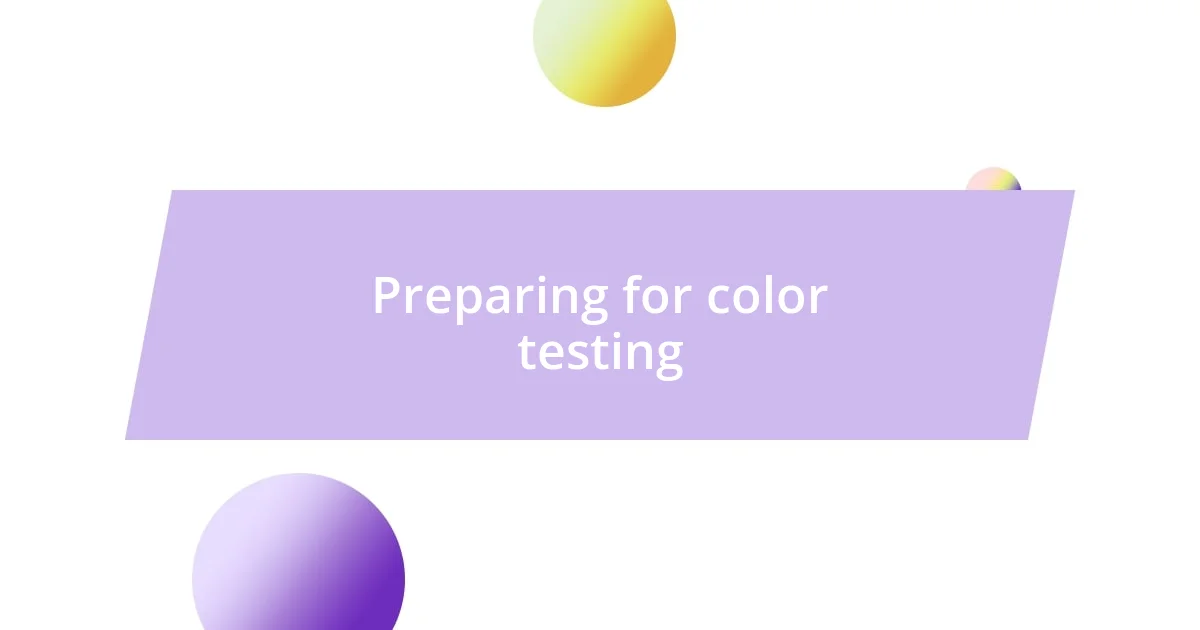
Preparing for color testing
Preparing for any kind of color testing is both exciting and methodical. Having a clear plan helps me feel grounded. One of my own rituals involves gathering all the glass samples I’ll test— laying them out like pieces of a puzzle, where each color adds a unique dimension to my creative process.
As I prepare, I focus on the tools I’ll need. For me, it’s essential to have gloves, a light source, and a white backdrop. The gloves prevent fingerprints from altering the glass’s appearance, and I always want a pristine viewing experience. Remember that lighting can drastically shift the perception of glass color, so I prefer experimenting under the same conditions I plan to use in my actual project.
I also like to create a testing grid. It helps me organize and compare each shade side by side, making it easier to visualize how they interact with one another. Have you ever been overwhelmed by choices only to realize the right one was right in front of you? For me, this grid technique often reveals a surprising favorite I might have overlooked.
| Preparation Step | Description |
|---|---|
| Gather Samples | Collect various glass pieces to assess the full range of colors. |
| Use Appropriate Tools | Ensure you have gloves, light sources, and a white backdrop ready for testing. |
| Create a Testing Grid | Organize glass samples for easy comparison during the evaluation phase. |
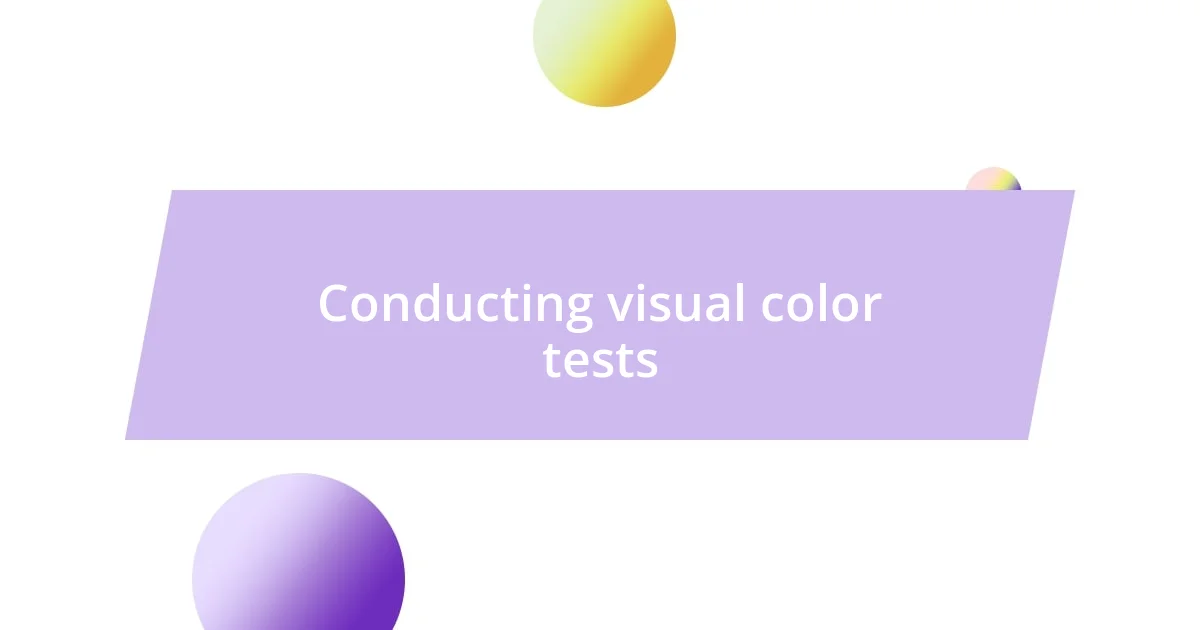
Conducting visual color tests
Conducting visual color tests is an exhilarating part of my creative process. When I set up my workspace, I often think about how a single color can transform the room’s energy. Have you ever noticed how one piece can completely alter your perception of space? I recall an instance when a vibrant orange piece unexpectedly brightened an otherwise dull corner, igniting a spark of inspiration for the entire design.
As I closely examine each glass sample, I take my time to truly immerse myself in their colors and textures. I often find myself shifting the glass around, observing how the light plays off its surface. This exploration reveals depths I might miss at first glance, almost like discovering hidden emotions in a familiar song. The right color can evoke nostalgia, excitement, or serenity—so it’s crucial to engage all my senses during this stage.
Finally, I remind myself to look at the glass against different backgrounds. I’ve learned that the surrounding elements can drastically influence my perception of color. One night, while testing under warm overhead lights, I noticed a particular blue glass took on an unexpectedly rich depth. This experience confirmed my belief that context matters as much as the glass itself. What colors resonate with you when viewed in different settings? I encourage you to explore this—it can lead to delightful surprises.
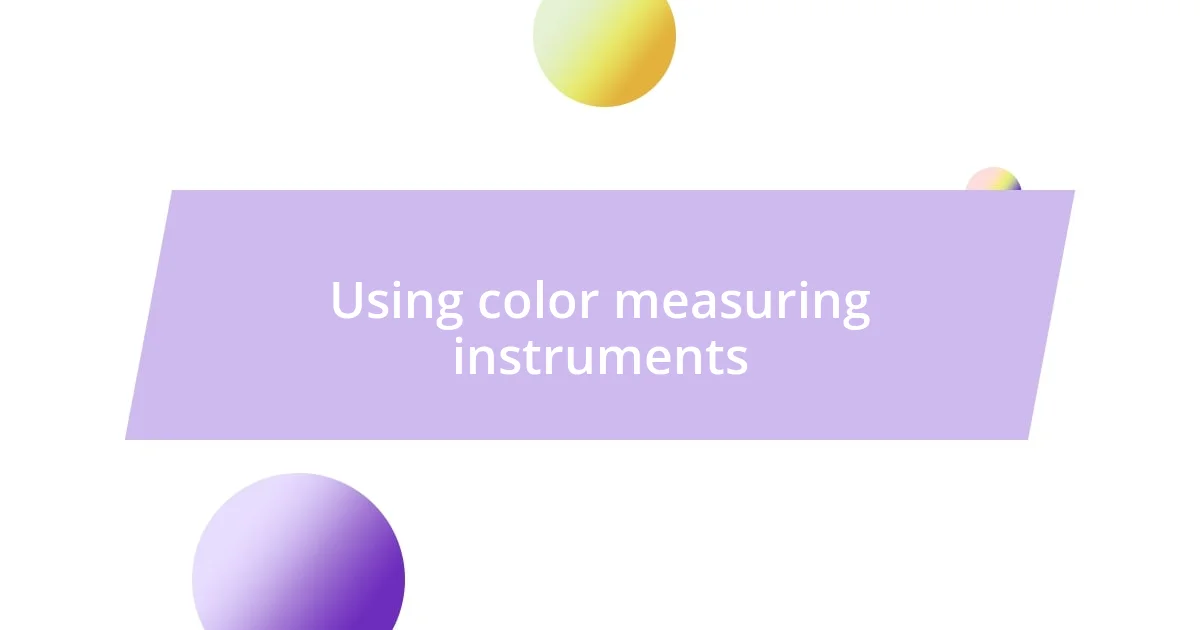
Using color measuring instruments
Using color measuring instruments has become an integral part of my testing process. I remember when I first invested in a spectrophotometer; it was like unlocking a new dimension to my understanding of color. With precise readings, I can confidently assess how each glass sample measures up to my creative vision, ensuring that my choices are based on solid data rather than gut feelings. Have you ever wished you could quantify your favorite colors? That’s what these tools do—they transform subjective choices into objective information.
In practice, I find that utilizing these instruments helps me benchmark colors more accurately. For instance, when testing a batch of colored glass, I often input readings into software that allows for side-by-side comparisons. The vivid graphs produced can highlight differences I might not notice with the naked eye. I once had a moment of revelation when data showed slight variations in shades that were nearly indistinguishable visually. It was a reminder of how nuanced color can be! Have you experienced that “aha” moment in your work?
One essential aspect of using color measuring instruments is consistency in testing conditions. I recall a time when I forgot to calibrate my device before assessing a new glass color. The results were unexpectedly skewed, leaving me confused about the choice that, as it turns out, was perfect under the proper settings. This taught me the value of thorough preparation: just like I wouldn’t skip gathering my samples, I now prioritize instrument calibration to ensure I capture the full potential of each color. Consistent conditions always yield more reliable data, reinforcing my commitment to accuracy. What steps have you taken to ensure the integrity of your color testing?
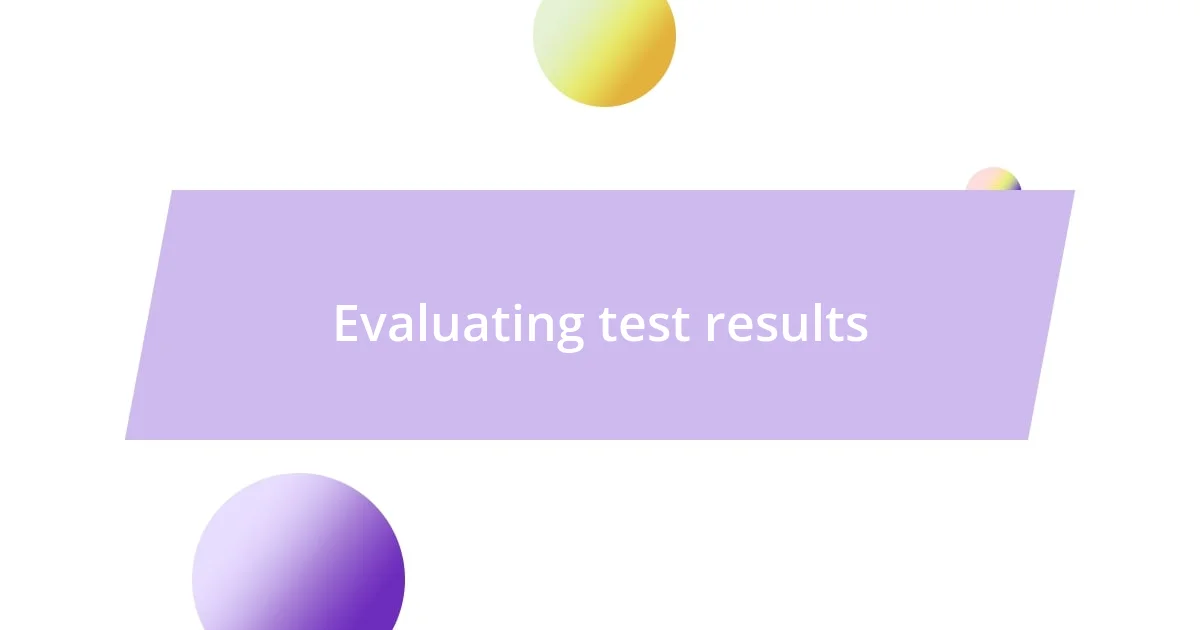
Evaluating test results
Assessing the results of my color tests can be both enlightening and challenging. When I review the data, I often feel a blend of excitement and anxiety. One time, I had high hopes for a new green hue, but the results revealed that it didn’t meet my expectations. That moment made me realize how important it is to remain open-minded; the data may show me something different than what I initially envisioned. Have you ever felt that twinge of disappointment when your vision clashed with reality?
Often, I lay out all my test results in a visual format. I find that seeing my findings side by side allows me to spot trends I might overlook otherwise. Last week, I recorded some reds that, while similar in hue, had significant differences in saturation and brightness. It was a genuine eye-opener to see how these subtle variations could affect the overall design. Can you recall a time when observing your work in a different light led to a breakthrough?
I also keep meticulous notes throughout my testing process. Not only does this help me track my findings, but it allows me to reflect on my emotional journey as well. I remember one instance where I noted my frustration with a particular shade, yet as I kept reviewing my notes, I discovered connections between my feelings and the colors I was drawn to. This introspective practice deepened my understanding of how color affects not just visuals but also emotions. Have you ever considered how your feelings influence your color choices?

Documenting your findings
Documenting my findings is a critical step in the color testing journey. I often find myself developing a structured system to log each glass sample’s details—everything from the hue to its reflective properties. One time, during a particularly ambitious project, I created a spreadsheet that not only tracked color values but also included notes about my inspirations and intended uses for each shade. Looking back, that document became a treasure trove of insights, reminding me of the creative sparks that drove my choices.
In my experience, revisiting my documentation often sheds new light on my artistic direction. I remember reviewing my past notes and feeling a wave of nostalgia for the feelings they evoked. I had labeled a specific shade of blue as “calming” during one testing session, and when I came across that entry a year later, it resonated with my current projects. This kind of reflection helps me understand not just the technical aspects of color but also the emotional connections woven into my work. Have you ever looked back at your notes and had a revelation about your own creative process?
I also find that sharing my documented findings can foster collaboration and inspire others. After organizing my data from a recent glass collection, I hosted a small critique session with fellow artists. I presented my findings, and we dove into discussions around not just the technical data but also the emotional narratives behind our choices. That engagement added layers to my understanding and highlighted how documentation can transcend mere record-keeping to become a source of community connection. Have you considered how sharing your documented findings might enrich your creative discussions?


